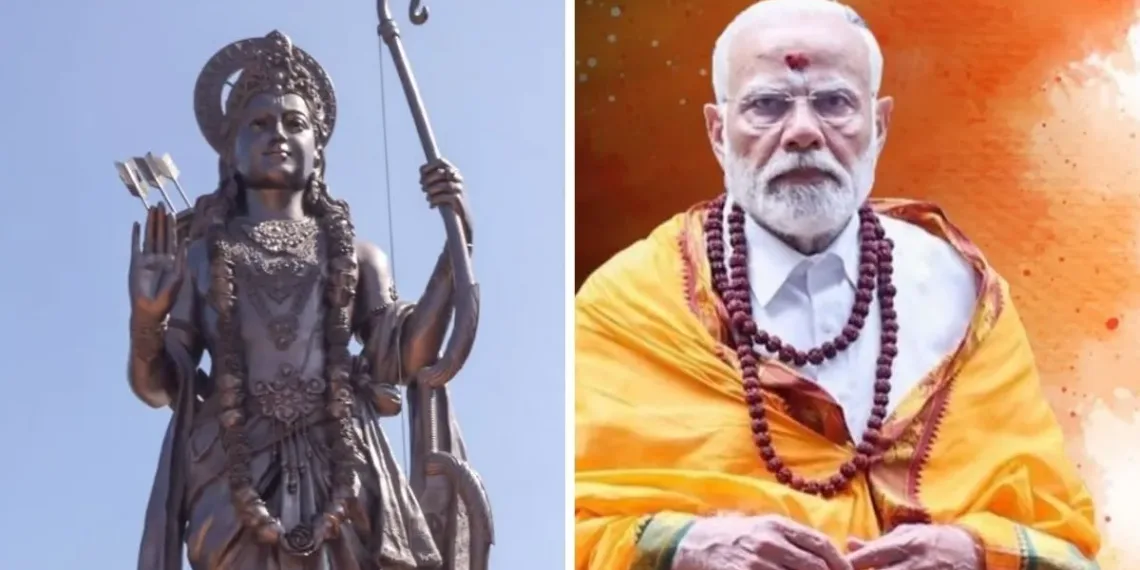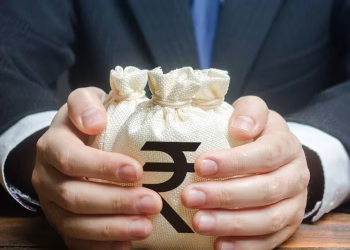Prime Minister Narendra Modi unveiled a magnificent 77-foot bronze statue of Lord Ram in South Goa on November 28, marking a historic moment in India’s spiritual and cultural landscape. The statue was revealed as part of Shree Samsthan Gokarn Jeevottam Mutt’s 550th year celebrations, drawing over 15,000 devotees from across the nation.
Table of Contents
PM Modi : Event Highlights at a Glance
| Aspect | Details |
|---|---|
| Statue Height | 77 feet (World’s Tallest Lord Ram Statue) |
| Material | Bronze |
| Location | Partagali, Canacona, South Goa |
| Sculptor | Ram Sutar (Statue of Unity creator) |
| Event | 550th Anniversary of Partagali Math |
| Attendees | 15,000+ devotees |
| Date | November 28, 2025 |
The Statue That Stands Above All
Sculptor Ram Sutar, who designed the Statue of Unity in Gujarat, created Lord Ram’s statue, making this the world’s tallest statue dedicated to the deity. The bronze masterpiece depicts Lord Ram holding his iconic bow and arrow, symbolizing righteousness and dharma.

The statue’s unveiling took place at Shree Samsthan Gokarn Partagali Jeevottam Math, located in Partagali, a serene village on the banks of the Kushavati river in South Goa’s Canacona district. This spiritual institution represents the first Gokarna Math of the Gowd Saraswat Brahmin community, following the Dvaita tradition established by Jagadguru Madhvacharya in the 13th century.
More Than Just a Statue: A Cultural Experience
Beyond the statue unveiling, PM Modi inaugurated several significant additions:
Major Inaugurations:
- Ramayana Theme Park – An immersive cultural destination showcasing the epic
- Special Postal Stamp – Commemorating the 550th anniversary
- Commemorative Coin – A collector’s tribute to the historic occasion
The event scale is massive: tens of thousands of devotees attended today, with over 1.2 lakh expected over the full 11-day festival running from November 27 to December 7, 2025.
The Historic Partagali Math
The mutt premises in Goa was constructed at Partagal village 370 years ago, serving as a spiritual beacon for the Saraswat community. The entire complex underwent extensive refurbishment for the celebrations, blending heritage preservation with modern infrastructure.
What makes this Math significant:
- One of India’s oldest monastic institutions
- 550 years of unbroken spiritual tradition
- Cultural and social contributions spanning centuries
- Headquarters of the first Gowd Saraswat Brahmin Vaishnava Math
Special cultural programs featuring renowned artists Shankar Mahadevan and Anup Jalota added entertainment to the spiritual festivities, creating a perfect blend of devotion and celebration.

A Day of Dual Devotion
Before arriving in Goa, PM Modi participated in the Laksha Kantha Gita Parayana programme at Sri Krishna Matha in Udupi, Karnataka, where approximately 1,00,000 participants recited the Srimad Bhagavad Gita in unison—demonstrating the day’s broader spiritual significance across South India.
The Prime Minister also inaugurated the Suvarna Teertha Mantapa and dedicated the Kanaka Kavacha (golden cover) for the sacred Kanakana Kindi at the Krishna temple, making November 28 a landmark day for Hindu cultural heritage.
Dignitaries in Attendance
Goa Governor Ashok Gajapathi Raju, Chief Minister Pramod Sawant and Union minister Shripad Naik, along with the state cabinet ministers, were present for the function, underscoring the event’s national importance.
A special helipad was constructed within the Math premises to facilitate the Prime Minister’s arrival, highlighting the meticulous planning behind this historic occasion.
Future Vision: Partagali as Pilgrimage Hub
With the new Ramayana Theme Park and museum zone, Partagali is positioned to become a major cultural and pilgrimage destination. The Math expects 7,000-10,000 daily visitors throughout the celebration period, signaling growing interest in spiritual tourism.
For those inspired by India’s rich spiritual heritage and cultural landmarks, TechnoSports covers diverse stories spanning tradition to modernity, including how Indian gaming culture is evolving while maintaining deep cultural roots.
Official Coverage and Resources
For comprehensive coverage and official updates, visit:
- Prime Minister’s Office (PMO) official website
- Press Information Bureau for government announcements
- Goa Tourism official portal for visiting information
The 77-foot statue now stands as a testament to India’s enduring spiritual traditions, architectural excellence, and cultural continuity—a symbol visible for miles that reminds visitors of values transcending time.
Frequently Asked Questions
Why is this Lord Ram statue considered the world’s tallest?
At 77 feet, this bronze statue is the tallest statue of Lord Ram in the world, surpassing all previous statues dedicated to the deity. Created by Ram Sutar, the legendary sculptor behind Gujarat’s Statue of Unity (the world’s tallest statue overall at 597 feet), this Ram statue represents cutting-edge bronze casting techniques combined with traditional iconography. The statue’s height makes it a landmark visible from considerable distances, transforming Partagali into a significant pilgrimage destination. Unlike smaller temple installations, this monumental scale allows the statue to serve both devotional and cultural tourism purposes, attracting visitors nationwide and potentially internationally as word spreads about this architectural marvel.
What is the significance of Shree Samsthan Gokarn Partagali Jeevottam Math’s 550th anniversary?
The 550-year milestone marks over five centuries of unbroken spiritual lineage for the Gowd Saraswat Brahmin community’s first Vaishnava Math. Established following the Dvaita philosophical system by Jagadguru Madhvacharya in the 13th century, this Math has served as a spiritual, cultural, and social anchor for generations. The anniversary celebrations running from November 27 to December 7, 2025, feature multiple cultural programs, spiritual discourses, and the inauguration of the Ramayana Theme Park—transforming the 370-year-old Goa premises into a modern pilgrimage hub. The event represents not just religious commemoration but also cultural preservation, showcasing how ancient institutions adapt while maintaining core traditions, making it relevant for contemporary devotees while honoring historical continuity.








